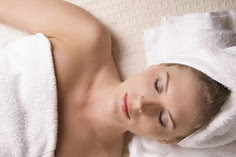 The gift of a rose is also one of the simplest ways to say, "I love you" without too much hocus-pocus. The thorns on its stems represent the "prick" of love and the overcoming of obstacles to achieve your desires. It is the pinnacle of metaphorical purity and symbolizes completion and perfection.
The gift of a rose is also one of the simplest ways to say, "I love you" without too much hocus-pocus. The thorns on its stems represent the "prick" of love and the overcoming of obstacles to achieve your desires. It is the pinnacle of metaphorical purity and symbolizes completion and perfection.The element associated with the rose is Water, so it is particularly friendly to the astrological signs of Pisces, Cancer and Scorpio. Both Mercury and Venus rule this flower. A bath in rose petals or rose water (which is distilled from the buds) is said to attract love to the bathing beauty.
An ancient custom is to sprinkle the bed of newly weds with rose petals to sweeten the initial carnal relations. In ancient alchemical formulas the red rose is used as a masculine principle and the rose represents the feminine or receptive principle. The combination of the two (perhaps growing the two bushes intertwined in the garden) represents harmony and unity.
 Rose oil, which is extracted through a rather expensive process from the petals of the flower, is also prominent in both love and healing rituals. When applied the temples the oil is said to cure a headache. When applied to the thighs or breasts it is supposed to attract a suitor. As an essential oil, the rose's essence is thought to relieve depression, PMS and postnatal depression.
Rose oil, which is extracted through a rather expensive process from the petals of the flower, is also prominent in both love and healing rituals. When applied the temples the oil is said to cure a headache. When applied to the thighs or breasts it is supposed to attract a suitor. As an essential oil, the rose's essence is thought to relieve depression, PMS and postnatal depression.It is also said to cure frigidity and impotence. Bach's Herbal Remedies makes a distillation of the Wild Rose.
Taking drops of this under your tongue is thought to help the patient free themselves from a rut or feelings of hopelessness and being trapped by fate. Rose water is used in cooking spells and added to curries and cake mixes to infuse the dish with good spirits and love attracting qualities. The water is also splashed on the skin (but not around the eyes) to give you a complexion as dewy as the flower.
The rose historically also symbolizes the female genitalia and is associated with Cupid, Eros, Adonis, Aphrodite, Isis, Hathor, and Demeter. Rose water and rose petals are often used in magical rituals to honor these gods and goddesses.
Although red roses are traditionally seen as symbols of lust, love and the flower also has a long association with such qualities as purity, compassion and divine perfection. The white rose in particular has an affinity with the Virgin Mary and the Holy Spirit.
The color of the rose is also significant. Red roses symbolize love, sex and passion. Pink roses suggest friendship, joy, gratitude and fun. Yellow roses can symbolize enthusiasm, but according to some folklore, the yellow rose can symbolize deception or "the perfect crime." Orange roses signify enthusiasm, passion and a lust for life. White roses are symbolic of significant landmarks in life (such as death, birth and marriage), unconditional love, purity and innocence.
The flower is not the only part of the rose that is used in divination and magic. To discover their romantic future, women used to take pluck three green rose leaves and name one after each of their suitors. The one that stayed green the longest was her soulmate. Rose hips can be strung like beads on a thread and worn as a necklace to attract love. Drinking rose-hip tea is thought to increase one's powers of prophecy.
Ironically, for a flower that is often given as a gift, the most powerful roses are said to be those that have been stolen from another person's garden.


























